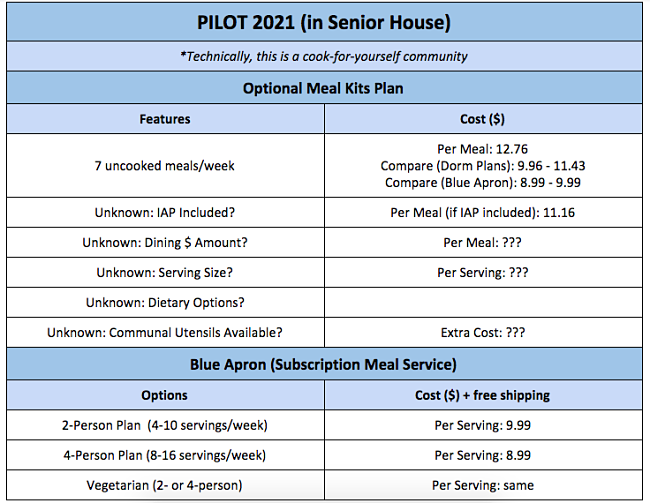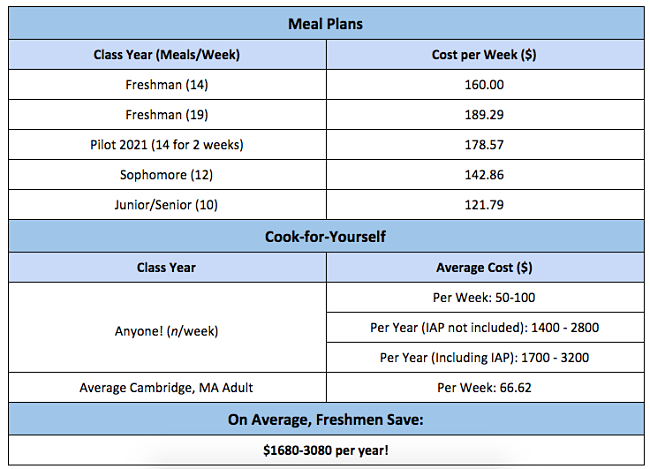How to Survive in a Cook-for-Yourself Community by Yuliya K. '18
and why meals plans are terrible
This post is dedicated to 2021s who aren’t sure if they can survive in a cook-for-yourself community. It could be helpful for parents as well.
Note on Update: this post has been updated with a section on the new Pilot 2021 optional meal kit plan. The appendix also compares it to non-MIT subscription meal services. Spoiler: it’s expensive. Update on Update: although Pilot 2021 was canceled, I’m leaving the section about it for information about non-MIT meal kits and meal prices in general. The section is also a cautionary tale about dining claims.
First, an important note: you are required to purchase a meal plan if you live in a dorm with a dining hall. I strongly believe that you shouldn’t pick a dorm based on the presence or absence of dining (unless cost is an important factor, in which case a meal plan is not advisable, see appendix). At MIT, where every dorm is different because of its culture, convenience should not be in the top 5 reasons for choosing a living space.
Another Important note: this is not a post advocating for certain dorms. Any undergraduate can get a meal plan regardless of where they live. The final section of the post offers ways to feed yourself in a non-dining community for all cooking skill levels.
Why You Should Not Get a Meal Plan
A bit about me: I cannot cook. I had a meal plan during the first semester of freshman year. This post is based on personal experience.
A freshman plan includes either 19 or 14 meals a week, and missed dining opportunities do not transfer to later dates. Meals are all-you-can-eat once you enter the dining hall.
I have many regrets about getting a meal plan. That first semester, I lost too many opportunities to bond with friends and neighbors. Cook-for-yourself communities allow students to connect and foster food-related traditions. They also incentivize exploring the Greater Boston cuisine. A meal plan gives no leeway for off-campus adventures.
To be fair, for people who eat large meals (e.g. athletes), a meal plan might be a great deal. For me, it wasn’t. Every dinner, I would gorge on stir-fry and Danish pastries and feel way more than full. Dieticians suggest consuming multiple small meals throughout the day; I got most of my calories in two giant portions before 10am and after 6pm. For the time in between (since lunch was not included), I took a small dessert, bagel, or fruit from the dining hall and try to go to grocery stores as rarely as possible. By the end of the semester, after long nights of work, I couldn’t wake up for the 8-11am breakfasts and had no food in the mornings. When Thanksgiving came, and the dining halls closed, I was completely unprepared.
Another important drawback of the meal plan is the often poor food quality that varies by the dining hall (but not by the price). My freshman year, Maseeh Dining (the closest dining hall to the East Side) served one healthy dinner option, stir-fry, which required standing in line and waiting for the order to be freshly cooked. The rest of the food was hardly worth it, the pizza being especially awful. The milk was sometimes sour, and the vegetables often dry, left in the open for the whole day. Last year, a student found potentially elevated arsenic levels in the halls’ apple juice. Despite these mistakes, the staff always ensured that the students don’t break the rules; I was reprimanded for even approaching the lunch salads after breakfast time ended.
My eating habits and digestive health improved significantly once I quit the meal plan, and I saved a ton of money. The cost comparison table in the appendix below shows that freshmen who feed themselves save, on average, $1680-3080 per year. If you eat common breakfast foods and light lunches, you can eat out every day and still stay under the $100/week budget (compared to $158 for just 14 meals)!
Read Joel’s ’18 similar critique of his freshman year meal plan experience here (not adjusted for inflation). Also read the comments below for some excellent additions to this post.
Bonus: a recent post on SaveSeniorHouse.mit.edu highlighted that the average Boston-Newton-Cambridge, MA adult spends only $3,464 on food per year (source). That’s only $67 per week, or about 2.4 times less than the cheapest MIT freshman meal plan. And that is considering that Boston is the 4th most expensive city in the U.S., with grocery costs exceeding the national average by more than 20% (source).
Why You Should Not Get a Pilot 2021 Meal Kits Plan
The MIT Housing website claims this optional plan for Pilot 2021 residents is “more economical.” That is false: the basic freshman meal plan is $4,480 for 14 meals/week, while the Pilot 2021 plan is $2,500 for 7 uncooked meals/week (plus the money you will spend on the rest of your week’s meals). This means the Pilot 2021 plan costs $12.76 per meal (assuming it doesn’t include IAP, like the other dorm plans). That is a lot, even by Greater Boston standards. For that amount, you can get a giant burger with fries at Mr. Bartley’s Burger Cottage, the best burger venue in the area with a history of celebrity drop-ins (and I doubt Tyra Banks or Robert Plant will visit Senior House).
Additionally, the Pilot 2021 plan cost does not account for the time you’ll spend cooking the meal kits, which is likely much longer than just microwaving a frozen meal in a cook-for-yourself community. And remember that you’ll still need time to go to a grocery store for the remainder of your weekly meals. So you’ll have to shop/budget/plan on your own and cook at least 7 meals outside of that. If your parents are worried about your ability to eat regularly and properly, the Pilot 2021 is not the best solution—it’s extremely difficult to cook 7 times a week. You will also be less likely to find experienced upperclassmen in Pilot 2021 to help you with more complex recipes.
Of course, the Pilot 2021 plan does include some “built-in dining dollars” for eating out at a nearby cafe, but it’s unclear what the amount of this dollars is, nor what food will be available for that money. There are other major unknowns in the optional plan, primarily, what counts as one meal? A traditional meal plan is all-you-can-eat for every meal; how large is a one-meal kit? Is it enough for athletes or other students with high-protein diets? Can kits accommodate people’s various dietary needs, i.e. vegetarian, gluten-free, kosher/halal etc? Are there instructions or simpler recipes for the less-experienced freshmen? What kind of communal utensils and cooking aides be available?..
I could go on, but that would likely exceed the acceptable number of question marks per paragraph. The important takeaway here is that the $2,500 plan is mysterious, time-consuming, and definitely less economical.
Bonus (alternative subscription meal boxes): there are plenty of non-MIT subscription food services that offer more flexibility and clarity for a larger variety of diets. They all offer cheaper options and discounts for first-time customers. Some options are Blue Apron (most popular, see cost comparison in appendix), Hello Fresh, Plated, Sun Basket, Purple Carrot, Home Chef, Martha & Marley Spoon, BistroMD, etc. Here is a nice infographic from Observer to help you choose the service you need.
How to Feed Yourself (for All Skill Levels)
LEVEL 1: Cook-for-Yourself
Living in a cook-for-yourself community will be easy! The dorms’ kitchens normally have communal cooking appliances and utensils. My floor, for example, has a blender, several rice cookers, plates, cutlery, baking sheets, pans, and basic grocery necessities such as olive/canola oil, salt, spices, etc. There are two microwaves and three ovens, as well as a fridge for each class year. Don’t rush to buy extra kitchen stuff until you settle in your dorm and floor, though, as every community owns different items. To minimize money on the food itself, Level 1 residents usually cook large portions to last several days. They can easily spend only $50/week on food.
LEVEL 2: Cooking Co-Ops
The easiest option is cooking co-ops. You can start or join a cooking co-op in your dorm—you’ll only have to cook once every week or two, and can arrange to cook with another resident. There are existing cooking co-ops for a variety of diets (e.g. vegan).
LEVEL 3: Grocery Shopping and Frozen Meals
Find people to join you on grocery shopping trips. The closest stores are Starmarket, a small Target, and H-mart (an Asian grocery store) in Central Square, which is a 5-25-minute walk from cook-for-yourself dorms (or a 5-minute subway ride from East Campus). There are also free MIT shuttles every weekend to Costco, a large Target, Star Market, Trader Joe’s, and Whole Foods (and you can borrow a free MIT Costco card!). If you don’t want to wait until the weekend, get an MBTA pass and use public transportation to reach your favorite store. MIT students can purchase monthly MBTA passes at a 50% discount. Also use the unlimited MBTA trips to get fruits and vegetables at Haymarket, an impressively cheap outdoor weekend market downtown.
LEVEL 3 (Bonus): What I Do
I fall into the third tier and still save a ton of money compared to the meal plan. My friend and I buy the bulk of our lunch/dinner foods at Trader Joe’s once every two weeks or so, and eat out a couple of times a week. TJ’s can be more expensive compared to conventional supermarkets like Costco or Star Market, but its large selection of healthy frozen meal options makes it incredibly convenient. The frozen meals are easy to make in a microwave, pan, or oven. They can stay “fresh” longer so we don’t have to plan meals to ensure that perishable products are used in time. Between Trader Joe’s trips, I take the subway to Central Square to get milk and cereal from CVS, Walgreens, or Target. For dry or canned foods such as rice, pasta, or beef chili, I use Amazon Prime Pantry (Amazon is half off for college students).
LEVEL 4: Free Food
MIT hosts many educational events, which usually offer food. Theoretically, you could get a free dinner every day and learn something new from, say, Noam Chomsky. Some student groups also feed members. If you aren’t in a group and don’t have time for events, add your Kerberos to the free-food mailing list. And make sure to participate in food-related traditions at your living group. For example, our hall’s GRT (Graduate Resident Tutor) makes waffles every Monday, and, during finals week, we have Finals Feeds, with daily breakfasts and dinners cooked by residents.
BONUS: Read about feeding options from Joel G. ’18 here, and about farmers’ markets from Selam G. ’18 here. Check out some simple recipes for freshmen from Lydia K. ’14, MEng ’16 here and here. Browse MIT Admissions for relevant entries by other bloggers.
Appendix
*Weekly cost estimates exclude bonus guest passes (6-8 per semester for freshmen). Cost per week calculated based on a 14-week semester schedule.

*Blue Apron prices are comparable to other subscription meal service prices. Some services include additional dietary options or organic/locally sourced products.
